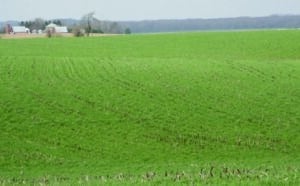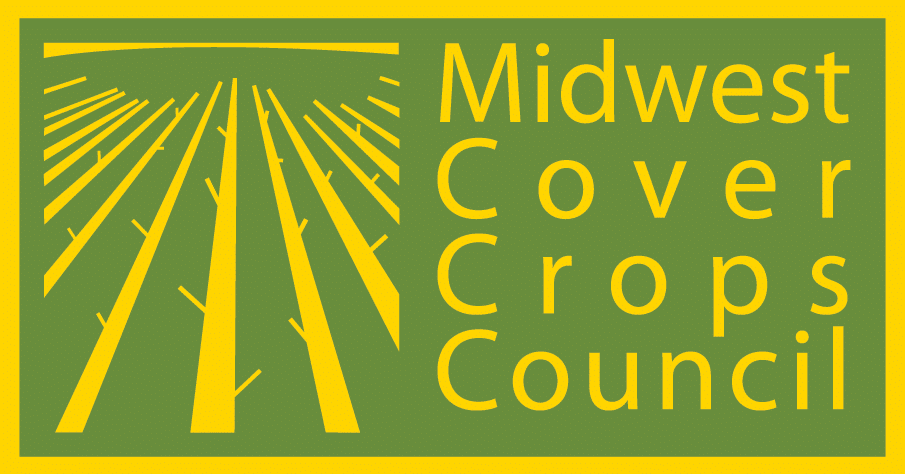Midwest Cover Crops Council (MCCC-103)
Iowa State University Extension (CROP 3158)
This publication is intended to provide a starting point for farmers who are new to growing cover crops. With experience, farmers may fine-tune the use of cover crops for their systems.
Introduction
The following recipe provides an introductory approach to integrating a cover crop into a corn-soybean rotation. Planting a cover crop ahead of a soybean cash crop is often the easiest way to introduce cover crops into your rotation.
Planning and Preparation
- Planning—Read about cover crops. Go to field days. Start small. Be timely. Prioritize management based on purpose and objectives.
- Corn hybrid and planting—If possible, plant preceding corn crop early and use an early maturity hybrid. Possible strategies are to use cover crops in a field that is usually harvested first, on sloping ground, or where you plan to plant your earliest maturity hybrid, corn silage, or seed corn.
- Residual corn herbicides—Cereal rye can be planted in the fall and produce a successful stand following most spring-applied residual corn herbicides. If cereal rye is grazed or harvested for forage, there are some time-interval restrictions. (See Resources.)
- Seed purchase—Order cereal rye seed early, usually by early August. Named rye varieties can produce substantially more growth and have predictable development, but they are usually more expensive than VNS (variety not stated) seed. Use good quality seed that has been cleaned, tested for germination and weed seed contamination, and purchased from a reputable seed dealer.
Fall Work
- Corn harvest—Harvest fields where cereal rye is to be planted as early as possible.
- Tillage or no-tillage—Generally, it is easier to integrate cover crops into no-till or strip-till systems. If full-width tillage is planned, do it immediately after corn harvest or delay it until after the planned cover crop termination date in the spring to allow time for cover crop growth.
- Timing of planting—Ideally, plant cereal rye as soon as possible after corn harvest and before two weeks after the average hard frost date (28˚F). In northern Iowa, this would roughly be before October 21; in central Iowa, before October 28; and in southern Iowa, before November 7. (See Cover Crop Management publication in Resources).
- Seeding rate—Minimum seeding rate: 45 lbs./acre. Beginners should consider 55 lbs./acre for drilled seed and 61 lbs./acre for shallow incorporation. Note that these rates assume the seed will have germination rates greater than 85%.
- Planting method—Drill to a depth of 0.75–1.50 inches or broadcast with shallow incorporation to less than 1.50 inches.

Spring Work
- Scouting before planting—In the spring, scout your cereal rye cover crop to determine how well it is growing and its coverage. If rainfall is below normal, then scout to monitor soil moisture in case earlier cover crop termination is needed.
- Termination timing—Terminate the cereal rye in spring when the plants are 6 to 12 inches tall and actively growing or more than 10 days before planting soybean—whichever comes first. Many experienced cover crop users will successfully terminate cereal rye much taller than 12 inches or less than 10 days before planting, but termination and planting may be more difficult for new users.
- Termination herbicide—Cereal rye can easily be terminated with a full rate of glyphosate (1 lb. acid equivalent/acre) after the rye begins growing in the spring. Effectiveness and rapidity of termination improves if rye is rapidly growing and air temperatures are warmer (> 60˚F). Larger rye, rye past the boot stage, or rye sprayed during cooler weather can be more difficult to kill, may require higher glyphosate rates, or will die more slowly. Use best management practices for glyphosate to improve effectiveness.
- Termination modifications for wet weather—In a wet or windy spring, when it has been very difficult to get into the fields to spray, be ready to take advantage of any break in the weather and/or use low axle weight sprayers. If projected soybean planting is less than 10 days away and the rye is tall, then it often works better to spray a day or two before planting. Crop insurance requires that cover crops be terminated at the very latest by five days after soybean planting in the southeastern two-thirds of Iowa and before soybean planting in the northwestern one-third of Iowa.
- Soybean planting—It is usually easiest to no-till plant soybean into the dead, brown cereal rye cover crop. Almost all modern row planters and drills are fully capable of planting soybean into a dead cereal rye cover crop. If wet or windy weather has delayed cereal rye termination, it is usually better to plant into standing green plants rather than into large green plants that are dying and have fallen on the soil surface, forming a mat. For either scenario, check planting depth and seed furrow closure shortly after beginning to plant because some adjustments are usually needed.
- Scouting after planting—Scout for soybean emergence, population, and insect pests. Additionally, scout for weeds because substantial cereal rye residue often can delay emergence of annual weeds, which may then delay the application of post-emergence herbicides.
Resources
Cover Crop Selector Tool — available from the Midwest Cover Crops Council
Cover Crop Management (Iowa Agronomy Technical Note 38)—available from the USDA Natural Resources Conservation Service
Effect of residual herbicides on cover crop establishment (Iowa State Extension and Outreach Integrated Crop Management Encyclopedia Article)
NRCS Cover Crop Termination Guidelines: Non-Irrigated Cropland—available from the USDA Natural Resources Conservation Service
Post Soybean, Going to Corn: Use Oats (Iowa Cover Crop Recipe series, MCCC-104)—available from the Midwest Cover Crops Council
Authors
Tom Kaspar, USDA-ARS (retired); Mark Licht, Iowa State University (Note: This publication was adapted with consent from MCCC under a joint project to produce customized introductory guidance about cover crops for all member states/provinces.)
Reviewers and Contributors
Shalamar Armstrong, Purdue University; Marisol Berti, North Dakota State University; Eileen Kladivko, Purdue University; Keith Kohler, USDA-ARS; Anna Morrow, Midwest Cover Crops Council; DeAnn Presley, Kansas State University; Vaughn Sothman, Sharp Brothers Seed Co., Kansas; and Anne Verhallen, Ontario Ministry of Food and Agriculture
Acknowledgments
This publication was developed with contributions and collaboration from Iowa Learning Farms and Practical Farmers of Iowa.
The Midwest Cover Crops Council (www.https://www.midwestcovercrops.org) aims to facilitate widespread adoption of cover crops throughout the Midwest by providing educational/outreach resources and programs, conducting new research, and communicating about cover crops to the public.
Funding for this project was provided by McKnight Foundation.
Revised May 2019
The U.S. Department of Agriculture (USDA) prohibits discrimination in all its programs and activities on the basis of race, color, national origin, age, disability, and where applicable, sex, marital status, familial status, parental status, religion, sexual orientation, genetic information, political beliefs, reprisal, or because all or a part of an individual’s income is derived from any public assistance program. (Not all prohibited bases apply to all programs.) Persons with disabilities who require alternative means for communication of program information (Braille, large print, audiotape, etc.) should contact USDA’s TARGET Center at (202) 720-2600 (voice and TDD). To file a complaint of discrimination write to USDA, Director, Office of Civil Rights, 1400 Independence Avenue, S.W., Washington, D.C. 20250-9410 or call (800) 795-3272 (voice) or (202) 720-6382 (TDD). USDA is an equal opportunity provider and employer. ©2019 by MCCC. All rights reserved.
